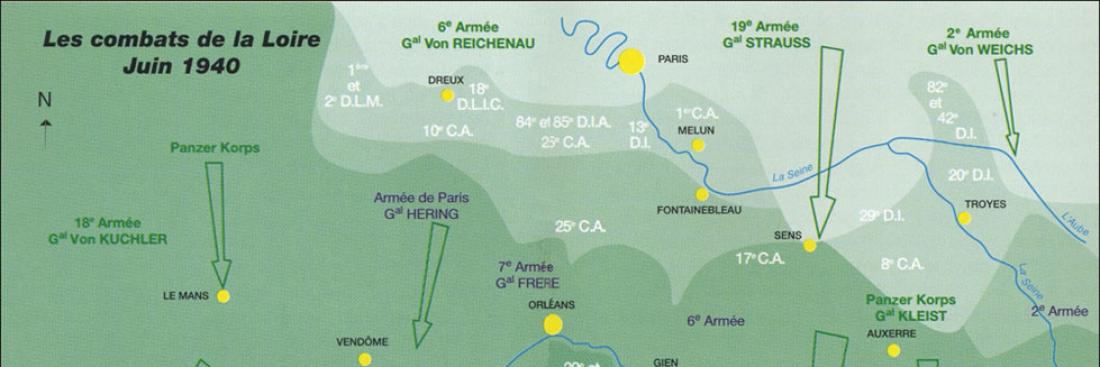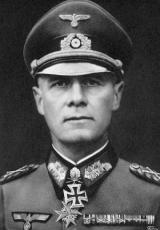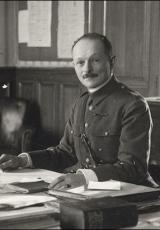Les combats de la Loire Juin 1940

Corps 1
Beginning on the 13th May 1940 with the breach of the Ardennes, the first phase of the Battle of France brought the German army along the Aisne and the Somme. On the 9th June 1940, General Besson's no. 3 group of French armies withdrew with difficulty. The 10th army beat a retreat from Versailles towards Alençon to join General Héring's 6th army (known as the "army of Paris") and General Frère's 7th in order to form a final defensive front along the Caen-Alençon-Fontainebleau-Sens line. General Georges set up headquarters in Vichy. As enemy pressure increased, these operations were carried out under constant attacks from the air whilst a flood of refugees poured in, with German tanks hot on their heels.
Corps 2
On the 14th June, the French government left Tours, where it had found refuge, and reached Bordeaux. On the 16th June, the 7th army crossed the obstructed bridges over the Loire. On its eastern flank, an enemy unit reached La Charité-sur-Loire where they created a bridgehead. On the 17th June, whilst Marshal Pétain, the new head of the French government asked for "a cease-fire", Hoth's 39th Panzerkorps attacked the 10th army to break through at Alençon. Taking advantage of this breach, they cut off the 10th army from the no.3 group of armies, taking its leader, General Altmayer, and his staff prisoner in Rennes. On the 19th June, Rommel's 7th Panzerdivision took Brest. In turn, Le Mans, Laval and Chartres were taken by the enemy. The German advance was violent. To the west they crossed the Loire between Nantes and Angers (not defended as they had been declared open cities), sweeping aside the remains of the French defences to take Niort, Poitiers and Angoulême. On the 22nd the Atlantic Ocean was reached at Rochefort. To the east, the onslaught of von Kleist's group of four tank divisions took Moulins, Vichy and Roanne and reached Lyon. In the middle of this pincer movement, the no. 3 group of armies beat a retreat behind the Loire on the 17th June, behind the Cher on the 19th and beyond the Indre on the 20th. It consisted of around 65,000 exhausted soldiers, made up of elements from the four armies. Millions of Belgian and French refugees fled to the south along the roads and by train, crossing the Loire in disorderly fashion at Saumur, Tours, Orléans and Gien and creating impossible traffic jams and unprecedented chaos. General Pichon of the 9th Military Region had organised the defences of the Loire to make it a delaying obstacle designed to protect the retreat of General Héring's army. He had worked enthusiastically to set up a front of defences that would perform their task to the very end, to their credit.
Along the river, the bridges were booby-trapped by engineers. At Saumur, the 17/2 company of the Anger 6th engineers carried out exhausting work in dangerous conditions. Assisted by S.N.C.F. employees, in two days sub-lieutenant Fraisier's sappers had laid mines on the 1,050m long iron bridge, handling the 1,700 kilos of melinite that would destroy two spans, whilst trains carrying evacuated civilians, equipment and the injured continually passed over it.
When the enemy arrived, charges exploded everywhere, blowing up bridges and viaducts at Ancenis, Ponts-de-Cé, Saint-Mathurin, Gennes, Montsoreau, Sully-sur-Loire and Gien, etc. Whenever light units tried to cross the river in boats, they were immediately thwarted by machine gun fire. Colonel Michon, in command of the Saumur Cavalry School, had been given the task of preventing the enemy from crossing between Candes and Le Thoureil, over a distance of 40 km.
He had 2,500 men, of whom many were without any experience of the war, but they were all driven by the greatest resolution to hold their fighting positions to the very end.
776 reserve officer trainees (558 from the cavalry and 218 auxiliaries) known as "the cadets" were split into 28 brigades of between 25 and 30 men. As weapons they had sub-machine guns, machine guns, 81mm mortars, 25mm canons, rifles and carbines, etc. These small brigades formed the motorised squadrons of Captains de Saint-Blanquat, Foltz and Marzolf and lieutenant de Saint-Germain's foot squadron, with 22 lieutenants and sub-lieutenants in command of the trainees. The 5th and 6th auxiliary companies (lieutenants Roimarmier and Doremus) consisted of eight brigades. In addition, Captain de Montclos' group consisted of 80 men.
Colonel Michon was assisted by 18 officers responsible for liaison, communications, supplies, transport and repairs etc. With a force of 209 men, the 1st Franc motorised cavalry group (Captain de Neuchèze) had five H39 tanks, four Panhard automatic machine guns and several motorcycles. 260 cavalrymen from the 19th dragoons made up Squadron leader Hacquard's group of four platoons. Also present were a reconnaissance battalion (Groupe de Reconnaissance de Division d'Infanterie or G.R.D.I.) of 200 men (Captain Gobbé), a detachment of 150 North African tirailleurs (Sub-lieutenant Parot), a group of three squadrons (captain de Cadignan) and around 350 men armed with anti-tank weapons. 120 sapper engineers were placed in defence of the bridges, whilst about sixty of Lieutenant Chanson's artillerymen from the Fontainebleau training school arrived on the 20th June with five well worn 75mm canons. On the same day reinforcements came in a battalion of reserve trainee officers from the Saint-Maixent infantry school commanded by captain Bleuse, a total of 568 cadets and 28 officers.
On the 19th at twenty past midnight, the Napoleon bridge, linking the island of Offard with the right bank, was blown up. A 25mm canon brought enemy vehicles to a standstill. At dawn in front of the gap left by the collapsed bridge, a German officer demanding the surrender of the defending men died under fire from the cadets. The enemy artillery then went wild, pounding Saumur. Lieutenant de Buffévent, whose command post was in the Place du Roi René, galvanised his trainees. The fighting was intense, inflicting losses on both sides.
The Germans fired using 88mm canons on the houses from where the Algerian tirailleurs sent a hail of bullet fire. Throughout the day and night the enemy arrived all along the defended sector, where bridges were blown up one after the other. They took up their position, testing the defences and preparing their resources for the crossing ahead.
From his command post in the Marsoleau inn, Colonel Michon gave his orders. As the southern bridges of Saumur and Gennes had been blown up, lieutenants de Buffévent and Desplats met up with their men on the islands where they had taken up position. Towards 9pm a first enemy operation to cross the Loire started. The Germans attacked the Island of Gennes where Desplats and his 1st brigade put up resistance. The assault, taken on its flank by fire from the 5th auxiliary company, was stopped after two hours of violent fighting.
At dawn on the 20th, the attack on Genes started again. The island was conquered and Lieutenant Desplats was killed. Llieutenant Roimarmier's unit had to withdraw. The officer was killed directing the delicate manoeuvre, his machine gun in his hand. Foltz's squadron advanced on Gennes in support.
Unsure of the German positions, Lieutenant de Buffévent left the island of Offard in a rowing boat to carry out a patrol with a few soldiers. Taken under fire by the enemy, he was killed along with a cadet called Raveton. To the east, units came across the river in force in several boats, advancing despite the losses inflicted upon them by the Panhard automatic machine gun, of Neuchèze's group.
At le Petit-Puy, the Allemands penetrated, attacking Hill 90 and the Aunis farm defended by the Saint-Blanquat squadron. Around12.l5, Saint-Maixent's cadets led by Captain Bleuse counter attacked with bayonets, supported by Lieutenant Pitiot's tank platoon. The attack proceeded, establishing contact with the men defending the Aunis farm, but failed under heavy enemy fire, which included anti-tank defences that destroyed two tanks, killing Pitiot and damaging the three remaining tanks. In the town, the defence of Saumur strengthened, with Lieutenants Perin, de Saint-Germain, and de la Lance leading the determination to hold out. But the enemy was advancing everywhere. At Gennes, they clashed with the 19th dragoons; Foltz's squadron launched a counter attack led by Lieutenant de Galbert.
In the evening a solid German bridgehead positioned on the right bank of the Loire took Saumur in a pincer movement. The defending men were exhausted and lacking in ammunition. The whole sector was about to become surrounded. But Colonel Michon had received the order from General Pichon to organise the retreat if it "became impossible to resist". At 7.30 pm the Colonel ordered his subordinates to withdraw in echelons to the south east between 9.30 and 9.45 pm. Captain Bleuse and his cadets dropped back at 10 pm to return to Chinon.
On the 21st June, at 2 O'clock in the morning, Colonel Michon, the Marzolf squadron and the Montclos detachment were surrounded at Lerné (Indre-et-Loire) and taken prisoner. Near Chinon, most of the Bleuse battalion was captured. On the 22nd Chanson and his men were taken to the Château de Chavigny. A few days later, all these prisoners were freed by the enemy and allowed to reach the non-occupied zone.
Despite glowing reports and requests for the attribution of a citation to the order of the Army to the three schools of Saumur, Saint-Maixent and Fontainebleau, on the 23rd August Generalissimo Weygand only granted it to the military school (E.M.A.C.T.) of Saumur. 392 cadets including 338 from the Saumur school were individually cited and awarded the Croix de Guerre.
The battles of the Loire led to many heroic events including, on the 18th June, Lieutenant Vallet's defence of Gien with a 75mm canon. The same day, at Sully-sur-Loire, the 140th infantry regiment (R.I.) and 141st alpine R.I. repelled three violent enemy assaults. Châteauneuf-sur-Loire and Jargeau were defended by the 21st and 109th R.I. On the 19th June at Ancenis, the fighting lasted all day. After the war on the 14th August 1948, the Ministry for national Defence would cite the towns of Saumur, Angers, Vierzon, Tours, Blois, Chambord and Fleury-lès-Aubrais on the Order of the Army. On the 11th November 1948, Les Ponts-de-Cé, Saint-Lambert-des-Levées, Segré, Gien and Orléans would be honoured in the same way. The text of Saumur's citation stipulates: " ... proved to be worthy throughout the whole war of the cavalry school's heroic attitude, which this city demonstrated in taking part with great self-sacrifice in the heroic resistance by the trainee officers of this school in 1940 and has deserved to be associated with their destiny... Its name constitutes one of the symbols of French patriotism."
Places of remembrance
Buried on the battlefields themselves under difficult conditions, those soldiers who fell during the battle of Saumur lay in rudimentary graves. In 1943, some were exhumed from Le Thoureil and brought to the local cemetery in Gennes. During the 1950's the town of Gennes carried out exhumations of bodies with permission from the families concerned and the "Saumur" and "Cadets of Saumur" ex-servicemen's associations. The mortal remains collected at Dampierre-sur-Loire, Doué-la-Fontaine and Gennes were buried on land donated by the town council near the Saint-Eusèbe chapel. In this memorial rest the 17 men who died for France in 1940: officers, reserve trainee officers and two tirailleurs. It was opened on the 21st June 1954 by General Ganeval representing the President of the Republic, Mr. René Coty, in the presence of the bishop of Angers, Monsignor Chappoulie, amid an ardent crowd of families, ex-servicemen and inhabitants. The other soldiers who fell in 1940 are buried in the National necropolis in Fleury-lès-Aubrais (Loiret) where there are the remains of 3,540 French men (635 from the 1914-18 war and 2,905 from 1939-45). This vast cemetery, spread over 2.5 hectares, was created in 1951. Between 1962 and 1965, it took in "those who died for France" in 1939-1945 that were exhumed in the départements of Seine-et-Marne, Seine-et-Oise, Eure, Eure-et-Loir, Loiret, Loir-et-Cher, Cher and Nièvre.



